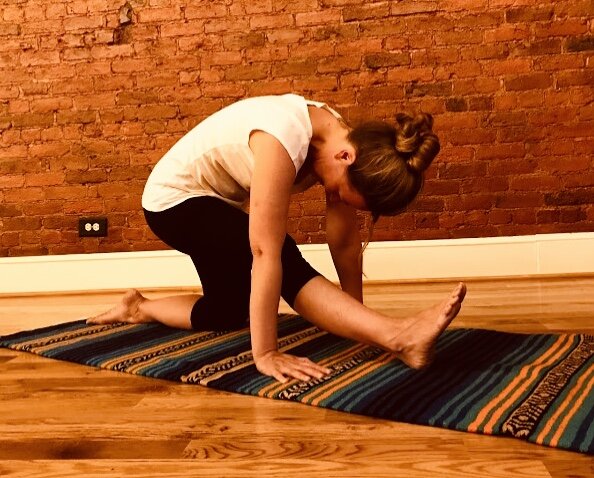Half Monkey Pose
Read the principles and benefits of Yin yoga below before practicing.
Benefits:
Deep hip opener
Hamstring, calves, and lower back stretch
Increases stability through the pelvis
Stimulates internal organs
Affected meridians:
Urinary and bladder
How to get into the pose:
Begin on all four. Step the right foot forward between the hands. The right knee is directly over the right ankle.
Extend the left leg behind you and shift the hips back unlit they align over the left knee.
Let gravity pull the hips down towards the mat. Place your hands on top of your yoga mat or blocks for support. Relax the head and let the back round.
Focus on your breathing - steady slow breaths through the nose.
Duration:
Hold the pose for 2 - 5 minutes on each side.
How to come out of the pose:
Come back to all four and press into the child's pose for one minute before practicing on the other side.
Props (using props during Yin practice helps you to be more comfortable in each pose):
Yoga mat and a blanket.
2 yoga blocks
Timer and soothing/relaxing music. You can also practice in silence.
Contraindications:
Avoid this pose if you have an injured lower back, hip, or hamstring
Always check with your healthcare practitioner before adding any new exercise.
..................................................................................................................................................
What is Yin Yoga?
Yin Yoga has its roots in China, unlike the more popular and active yoga practices, that originated in India. It was founded on the Taoist theory of yin and yang – opposite concepts that, together, represent balance.
There are around 20 classic poses (plus their variations) in Yin Yoga. Yin postures are primarily passive in nature and mostly performed while seated or in a reclining position. Yin poses are held anywhere from two minutes to five minutes (or even more) in order to target the body’s connective tissues, joints, and fascia rather than muscles.
Yin Yoga Principles:
1. Find your comfortable edge in each pose, the place where you feel a sensation but not over-stretching, stabbing, or burning pain. Keep in mind that less is more.
2. Remain still while in each pose. Focus on your breath, relax the muscles, and let the stretch go deeper into the connective tissues.
3. Hold each pose for a long time (2- 5 minutes), letting yourself open into the posture. Use a timer.
4. Release each pose slowly and with care. Take your time when coming out of a pose - go nice and slow.
5. Rest for 1 minute in between each pose to feel the after-effects.
Benefits of Yin Yoga:
Physical level - targets bones, release fascia and improves joint mobility.
Emotional level - Yin Yoga is a quiet practice that is truly a meditative practice that calms the body, and mind. Reduces anxiety and stress.
Energetic level - the practice reconnects with its roots of Taoist yoga and uses the ancient map of the Meridians. The long holds in Yin restore harmony in the subtle body by targeting the channels that run through the connective tissues. Improves the flow of chi or prana and balances internal organs.

